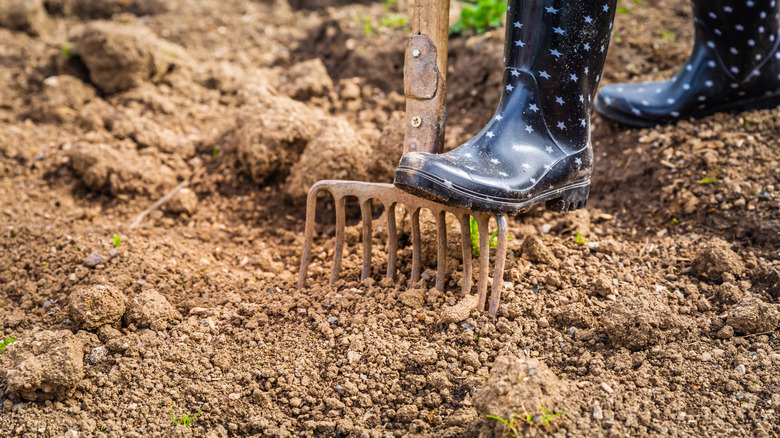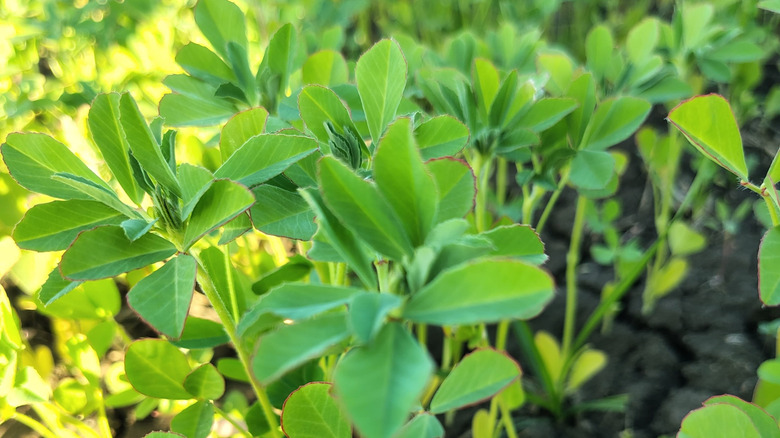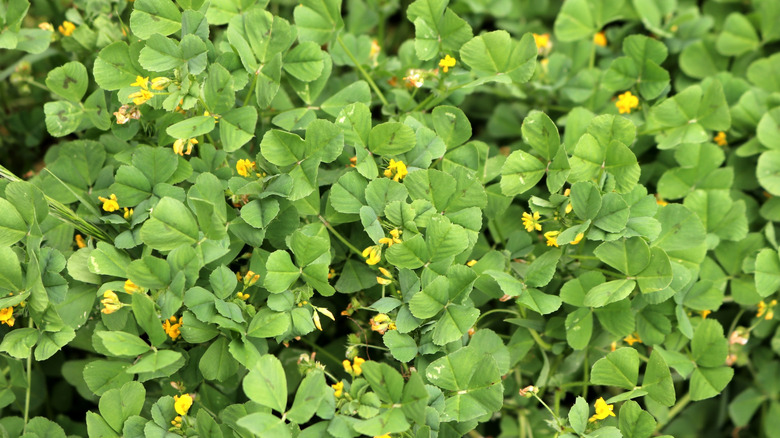The Herb You Should Consider Growing In Your Garden For Healthy Soil
We may receive a commission on purchases made from links.
Yellowing leaves, stunted growth, and abnormal root systems are all easy ways to tell if your garden soil is lacking in nitrogen. While applying a well-balanced commercial fertilizer will likely counter the issue, there are other more natural ways to tackle a nitrogen deficiency. Plants in the legume family are nitrogen fixing, meaning they hold onto the nitrogen they consume, feeding it back into the soil through their roots when they die. Planting them as a companion crop between vegetables is a great way to reap the benefits. But which legume should you choose? A lesser known herb in the pea family called fenugreek does more for the soil than contributing a vital plant nutrient. Grow it as a living mulch to remediate contamination, reduce erosion, break up compacted garden beds, suppress weeds, and maybe even reduce soil-borne pests.
Fenugreek (Trigonella spp.) has been cultivated for millennia as an annual crop. Seeds of the plant were found in the tomb of ancient Egyptian pharaoh Tutankhamun, perhaps unsurprisingly, since the plant is thought to come from Southern Europe and Asia — in particular, Afghanistan, Iran, Iraq, and Pakistan. While today there are dozens of species in the genus worldwide, many of which are considered native or naturalized, Trigonella feonum-graecum is the most widely cultivated. It goes by a number of other common names, including Greek hay, Greek hayseed, Greek clover, bird's foot, and goat's horn. It boasts trifoliate leaves (three to a stem) that look like clover leaves but larger. Fenugreek is used as a herb, adored for it's small white or purple blooms, and provides edible seeds.
The many ways fenugreek benefits the soil in your garden
Looking for ways to add nitrogen to your soil for a healthier garden in no time? Grow fenugreek as a winter cover crop and it'll do just that. The species acts as a host for soil bacteria called rhizobia, in particular Rhizobium meliloti, that collect nitrogen from the soil and air and build pink-hued nitrogen nodes on fenugreek roots. Seeds for use in agriculture are often inoculated with the right rhizobia, which are particularly tolerant to adverse environmental conditions, to improve the plant's nitrogen fixing capabilities.
In agriculture, fenugreek is sometimes used as a rotation crop — that is, it's planted between other harvestable crops — to help replenish nitrogen in spent fields. It boasts a moderate absorption rate by fixing over 600 pounds of nitrogen per about 2.5 acres annually. As a home gardener, you can use it similarly on fallow vegetable beds. Leave the roots in the soil after harvesting the leaves or seeds or chop the entire plant down, leaving it on the surface as a green manure, and you might be able to reduce the amount of nitrogen-based fertilizer you use.
Though fenugreek primarily improves soil through nitrogen fixation, that's not its only dirt-related benefit. The plant also uptakes heavy metals, making it a candidate for remediation of soils contaminated with lead, nickel, and chromium and surface water polluted by industrial or farm run-off. Fenugreek's hefty tap roots dig deep into the ground. Plant it in areas prone to soil erosion to preserve the topsoil or in old garden beds, where it will break up all that compacted soil in no time.
How to buy and plant fenugreek for the greatest soil benefits
When planted as a living mulch or ground cover under slow growing crops and plants, fenugreek shades the soil, regulating soil moisture, and encouraging beneficial insects. If planted densely, this hardy legume also acts as a weed suppressant, smothering weed seedlings and preventing seeds from germinating. That means less competition for the nutrients your soil contains. Planting fenugreek for a season (it's an annual, after all) might also disrupt the life cycles of soil-borne pests and diseases — corn rootworm, for example — and microbial infections. Some of the best companion plants for fenugreek intercropping include tomatoes, corn, or coriander. Note that this legume doesn't do well in saline soils, so beach-side gardeners may want to try a different plant.
Ready to grow this type of plant to create healthier soil in your yard and garden? Probably the easiest way to start a path of fenugreek is to sow seeds. How many you need depends on how large of an area you're sowing. Get a packet of 100 Instant Latch Non GMO Heirloom Fenugreek Seeds for about $6. Direct sowing is best; fenugreek doesn't like to be transplanted. You can also buy the seed as part of a cover crop mix. The Cannaisseur No-Till Cover Crop 13-Seed Mix costs $16 for a 1 pound bag and includes fenugreek, vetch, flax, cowpeas, buckwheat, forage peas, millet, lentils, and a selection of clovers. Select nurseries begin selling fenugreek seedlings when the weather grows warmer.


